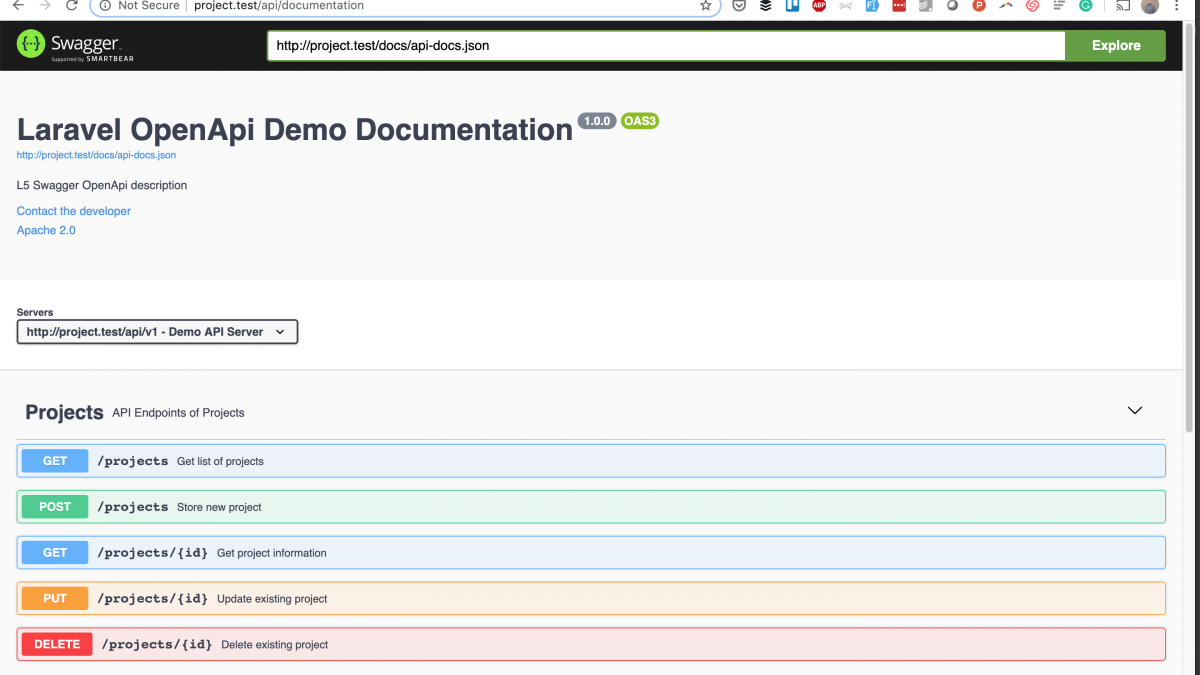Laravel API Documentation with OpenAPI/Swagger
 Povilas Korop
Povilas Korop
Founder of QuickAdminPanel
As a part of our QuickAdminPanel, we also generate APIs. But your goal is also to provide documentation for front-end who would consume that API, right? OpenAPI (ex. Swagger) is a well-known standard for that. How to apply it to a Laravel project?
In this article, we will have these sections:
- Short Intro: What is OpenAPI and How Does it Work?
- Preparation: Initial Laravel API Code
- Installing Laravel Swagger Package
- Writing Comments and Generating Documentation
At the end of the article, you will find a link to Github repository example.
Short Intro: What is OpenAPI and How Does it Work?
First, a few words about what OpenAPI/Swagger is.
Formerly called Swagger (quite often called this even now), OpenAPI is a standard of documenting APIs. Its specification is available on Github here.
The official definition from their homepage: “The OpenAPI Specification: a broadly adopted industry standard for describing modern APIs.”
Keep in mind that it’s not a Laravel API standard. Not even PHP language standard. It’s API schema that can be used for any programming language. It’s like a set of rules that can be adapted to your framework.
For Laravel specifically, there were a few packages created, and we will use one of them: DarkaOnLine/L5-Swagger
Let’s take a look at the end result – here’s the documentation page that will be generated automatically from your code comments:
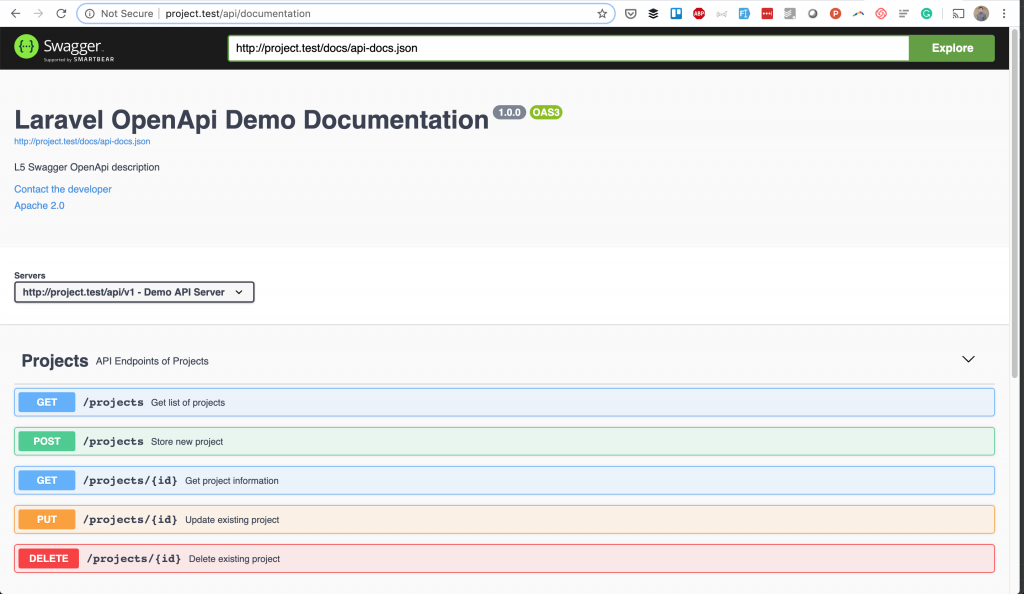
Inside this page, you can click on items to expand them and get more information.
And all of it because you have written some comments, like these:
class ProjectsApiController extends Controller
{
/**
* @OA\Get(
* path="/projects",
* operationId="getProjectsList",
* tags={"Projects"},
* summary="Get list of projects",
* description="Returns list of projects",
* @OA\Response(
* response=200,
* description="Successful operation",
* @OA\JsonContent(ref="#/components/schemas/ProjectResource")
* ),
* @OA\Response(
* response=401,
* description="Unauthenticated",
* ),
* @OA\Response(
* response=403,
* description="Forbidden"
* )
* )
*/
public function index()
{
abort_if(Gate::denies('project_access'), Response::HTTP_FORBIDDEN, '403 Forbidden');
return new ProjectResource(Project::with(['author'])->get());
}
So, this is a short overview, now let’s get deeper and show you how to generate the documentation step-by-step.
Preparation: Initial Laravel API Code
First, I will show the base code of API structure, it may be useful to learn even if you’re not planning to generate documentation.
Imagine you have a model Project and all API action for it: index, store, update, show, destroy.
So, here’s routes/api.php:
Route::group([
'prefix' => 'v1',
'as' => 'api.',
'namespace' => 'Api\V1\Admin',
'middleware' => ['auth:api']
], function () {
Route::apiResource('projects', 'ProjectsApiController');
});
In this example, we put the ProjectsApiController inside of V1/Admin subfolder.
So here’s the code of our app/Http/Controllers/V1/Admin/ProjectsApiController.php:
namespace App\Http\Controllers\Api\V1\Admin;
use App\Http\Controllers\Controller;
use App\Http\Requests\StoreProjectRequest;
use App\Http\Requests\UpdateProjectRequest;
use App\Http\Resources\Admin\ProjectResource;
use App\Project;
use Gate;
use Illuminate\Http\Request;
use Symfony\Component\HttpFoundation\Response;
class ProjectsApiController extends Controller
{
public function index()
{
abort_if(Gate::denies('project_access'), Response::HTTP_FORBIDDEN, '403 Forbidden');
return new ProjectResource(Project::with(['author'])->get());
}
public function store(StoreProjectRequest $request)
{
$project = Project::create($request->all());
return (new ProjectResource($project))
->response()
->setStatusCode(Response::HTTP_CREATED);
}
public function show(Project $project)
{
abort_if(Gate::denies('project_show'), Response::HTTP_FORBIDDEN, '403 Forbidden');
return new ProjectResource($project->load(['author']));
}
public function update(UpdateProjectRequest $request, Project $project)
{
$project->update($request->all());
return (new ProjectResource($project))
->response()
->setStatusCode(Response::HTTP_ACCEPTED);
}
public function destroy(Project $project)
{
abort_if(Gate::denies('project_delete'), Response::HTTP_FORBIDDEN, '403 Forbidden');
$project->delete();
return response(null, Response::HTTP_NO_CONTENT);
}
}
Here are a few additional things we need to mention:
- We use Laravel Gates to restrict the access;
- We use API Resources to return the response data;
- We use Form Request classes to validate the input data.
Here’s one of those files – app/Http/Resources/Admin/ProjectResource.php:
namespace App\Http\Resources\Admin;
use Illuminate\Http\Resources\Json\JsonResource;
class ProjectResource extends JsonResource
{
public function toArray($request)
{
return parent::toArray($request);
}
}
Also, for validation – app/Http/Requests/StoreProjectRequest.php:
namespace App\Http\Requests;
use Gate;
use Illuminate\Foundation\Http\FormRequest;
use Symfony\Component\HttpFoundation\Response;
class StoreProjectRequest extends FormRequest
{
public function authorize()
{
abort_if(Gate::denies('project_create'), Response::HTTP_FORBIDDEN, '403 Forbidden');
return true;
}
public function rules()
{
return [
'name' => [
'required',
],
];
}
}
So, here’s our beginning. Now, let’s start generating the documentation with OpenAPI.
Installing Laravel Swagger Package
One of the most popular packages to generate OpenAPI documentation in Laravel is DarkaOnLine/L5-Swagger.
Don’t be confused by the name – it didn’t change the name part of Swagger to OpenAPI, but it actually supports both standards. Also “L5” in the name is not important either – current Laravel 6 is supported well.
So, we install the package:
composer require darkaonline/l5-swagger
Next, following installation instructions in Readme, we publish config/views from Service Provider:
php artisan vendor:publish --provider "L5Swagger\L5SwaggerServiceProvider"
Finally, we have config/l5-swagger.php file with huge amount of options:
[
/*
|--------------------------------------------------------------------------
| Edit to set the api's title
|--------------------------------------------------------------------------
*/
'title' => 'L5 Swagger UI',
],
'routes' => [
/*
|--------------------------------------------------------------------------
| Route for accessing api documentation interface
|--------------------------------------------------------------------------
*/
'api' => 'api/documentation',
// ...
],
// ... many more options
/*
|--------------------------------------------------------------------------
| Uncomment to add constants which can be used in annotations
|--------------------------------------------------------------------------
*/
'constants' => [
'L5_SWAGGER_CONST_HOST' => env('L5_SWAGGER_CONST_HOST', 'http://my-default-host.com'),
],
];
For this example, we will edit the title from ‘L5 Swagger UI’ to ‘Projects API’, and add this into .env file:
L5_SWAGGER_CONST_HOST=http://project.test/api/v1
And then we should launch this magic command:
php artisan l5-swagger:generate
It should generate a JSON file, which then will be transformed into HTML page.
But, for now, it won’t generate anything, cause we haven’t added any comments anywhere. Shall we?
Writing Comments and Generating Documentation
This is probably the main part of this article – rules on how to write those comments and where exactly.
The package will scan all your files and look for the patterns of OpenAPI-related comments.
So, what types of comments we need to add?
- Global: Project comments
- Local: Controller/Method comments
- Virtual: Models, Validation and Response comments
I will just list the comments here, for more information on their logic please refer to the short examples inside of the Laravel package, or to the detailed OpenAPI official specification.
Comment Type 1: Global
We need to provide the information about the whole project, and for that, we create a separate file – an empty Controller which wouldn’t even be used anywhere – app/Http/Controllers/Api/Controller.php:
class Controller
{
/**
* @OA\Info(
* version="1.0.0",
* title="Laravel OpenApi Demo Documentation",
* description="L5 Swagger OpenApi description",
* @OA\Contact(
* email="admin@admin.com"
* ),
* @OA\License(
* name="Apache 2.0",
* url="http://www.apache.org/licenses/LICENSE-2.0.html"
* )
* )
*
* @OA\Server(
* url=L5_SWAGGER_CONST_HOST,
* description="Demo API Server"
* )
*
* @OA\Tag(
* name="Projects",
* description="API Endpoints of Projects"
* )
*/
}
These variables will help generate the main information in documentation page header:
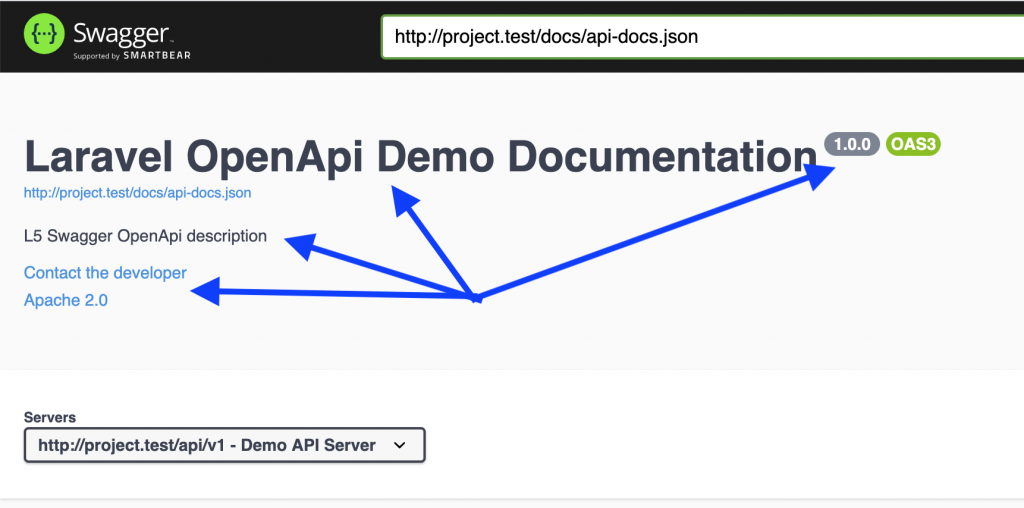
Comment Type 2: Controllers Methods
To describe every API endpoint, we need to add comments annotations on top of every method in API Controllers.
So here’s a full example of our app/Http/Controllers/Api/V1/Admin/ProjectsApiController.php:
class ProjectsApiController extends Controller
{
/**
* @OA\Get(
* path="/projects",
* operationId="getProjectsList",
* tags={"Projects"},
* summary="Get list of projects",
* description="Returns list of projects",
* @OA\Response(
* response=200,
* description="Successful operation",
* @OA\JsonContent(ref="#/components/schemas/ProjectResource")
* ),
* @OA\Response(
* response=401,
* description="Unauthenticated",
* ),
* @OA\Response(
* response=403,
* description="Forbidden"
* )
* )
*/
public function index()
{
abort_if(Gate::denies('project_access'), Response::HTTP_FORBIDDEN, '403 Forbidden');
return new ProjectResource(Project::with(['author'])->get());
}
/**
* @OA\Post(
* path="/projects",
* operationId="storeProject",
* tags={"Projects"},
* summary="Store new project",
* description="Returns project data",
* @OA\RequestBody(
* required=true,
* @OA\JsonContent(ref="#/components/schemas/StoreProjectRequest")
* ),
* @OA\Response(
* response=201,
* description="Successful operation",
* @OA\JsonContent(ref="#/components/schemas/Project")
* ),
* @OA\Response(
* response=400,
* description="Bad Request"
* ),
* @OA\Response(
* response=401,
* description="Unauthenticated",
* ),
* @OA\Response(
* response=403,
* description="Forbidden"
* )
* )
*/
public function store(StoreProjectRequest $request)
{
$project = Project::create($request->all());
return (new ProjectResource($project))
->response()
->setStatusCode(Response::HTTP_CREATED);
}
/**
* @OA\Get(
* path="/projects/{id}",
* operationId="getProjectById",
* tags={"Projects"},
* summary="Get project information",
* description="Returns project data",
* @OA\Parameter(
* name="id",
* description="Project id",
* required=true,
* in="path",
* @OA\Schema(
* type="integer"
* )
* ),
* @OA\Response(
* response=200,
* description="Successful operation",
* @OA\JsonContent(ref="#/components/schemas/Project")
* ),
* @OA\Response(
* response=400,
* description="Bad Request"
* ),
* @OA\Response(
* response=401,
* description="Unauthenticated",
* ),
* @OA\Response(
* response=403,
* description="Forbidden"
* )
* )
*/
public function show(Project $project)
{
abort_if(Gate::denies('project_show'), Response::HTTP_FORBIDDEN, '403 Forbidden');
return new ProjectResource($project->load(['author']));
}
/**
* @OA\Put(
* path="/projects/{id}",
* operationId="updateProject",
* tags={"Projects"},
* summary="Update existing project",
* description="Returns updated project data",
* @OA\Parameter(
* name="id",
* description="Project id",
* required=true,
* in="path",
* @OA\Schema(
* type="integer"
* )
* ),
* @OA\RequestBody(
* required=true,
* @OA\JsonContent(ref="#/components/schemas/UpdateProjectRequest")
* ),
* @OA\Response(
* response=202,
* description="Successful operation",
* @OA\JsonContent(ref="#/components/schemas/Project")
* ),
* @OA\Response(
* response=400,
* description="Bad Request"
* ),
* @OA\Response(
* response=401,
* description="Unauthenticated",
* ),
* @OA\Response(
* response=403,
* description="Forbidden"
* ),
* @OA\Response(
* response=404,
* description="Resource Not Found"
* )
* )
*/
public function update(UpdateProjectRequest $request, Project $project)
{
$project->update($request->all());
return (new ProjectResource($project))
->response()
->setStatusCode(Response::HTTP_ACCEPTED);
}
/**
* @OA\Delete(
* path="/projects/{id}",
* operationId="deleteProject",
* tags={"Projects"},
* summary="Delete existing project",
* description="Deletes a record and returns no content",
* @OA\Parameter(
* name="id",
* description="Project id",
* required=true,
* in="path",
* @OA\Schema(
* type="integer"
* )
* ),
* @OA\Response(
* response=204,
* description="Successful operation",
* @OA\JsonContent()
* ),
* @OA\Response(
* response=401,
* description="Unauthenticated",
* ),
* @OA\Response(
* response=403,
* description="Forbidden"
* ),
* @OA\Response(
* response=404,
* description="Resource Not Found"
* )
* )
*/
public function destroy(Project $project)
{
abort_if(Gate::denies('project_delete'), Response::HTTP_FORBIDDEN, '403 Forbidden');
$project->delete();
return response(null, Response::HTTP_NO_CONTENT);
}
}
Wow, it feels like A LOT of comments, right?
But that’s the correct way of preparing the documentation – you need to describe all the methods, all the cases, all the parameters, all the exceptions.
Comment Type 3: Model, Validation and Response
You may have noticed some references to external files in the comments in the Controller above. So what is StoreProjectRequest there? We define all of those rules in our folder called app/Virtual, see the list of files:
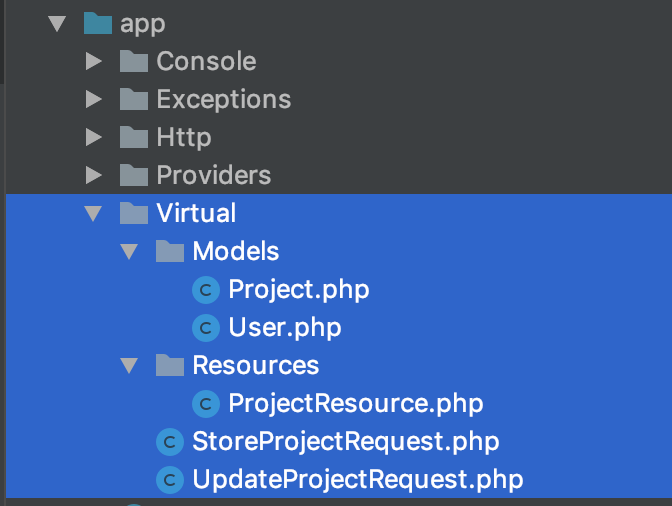
Let’s take a look inside of app/Virtual/Models/Project.php:
/**
* @OA\Schema(
* title="Project",
* description="Project model",
* @OA\Xml(
* name="Project"
* )
* )
*/
class Project
{
/**
* @OA\Property(
* title="ID",
* description="ID",
* format="int64",
* example=1
* )
*
* @var integer
*/
private $id;
/**
* @OA\Property(
* title="Name",
* description="Name of the new project",
* example="A nice project"
* )
*
* @var string
*/
public $name;
/**
* @OA\Property(
* title="Description",
* description="Description of the new project",
* example="This is new project's description"
* )
*
* @var string
*/
public $description;
/**
* @OA\Property(
* title="Created at",
* description="Created at",
* example="2020-01-27 17:50:45",
* format="datetime",
* type="string"
* )
*
* @var \DateTime
*/
private $created_at;
/**
* @OA\Property(
* title="Updated at",
* description="Updated at",
* example="2020-01-27 17:50:45",
* format="datetime",
* type="string"
* )
*
* @var \DateTime
*/
private $updated_at;
/**
* @OA\Property(
* title="Deleted at",
* description="Deleted at",
* example="2020-01-27 17:50:45",
* format="datetime",
* type="string"
* )
*
* @var \DateTime
*/
private $deleted_at;
/**
* @OA\Property(
* title="Author ID",
* description="Author's id of the new project",
* format="int64",
* example=1
* )
*
* @var integer
*/
public $author_id;
/**
* @OA\Property(
* title="Author",
* description="Project author's user model"
* )
*
* @var \App\Virtual\Models\User
*/
private $author;
}
See, we need to define every property of that Project model, including relationship to the author.
Now, what about form validation requests? See app/Virtual/StoreProjectRequest.php:
/**
* @OA\Schema(
* title="Store Project request",
* description="Store Project request body data",
* type="object",
* required={"name"}
* )
*/
class StoreProjectRequest
{
/**
* @OA\Property(
* title="name",
* description="Name of the new project",
* example="A nice project"
* )
*
* @var string
*/
public $name;
/**
* @OA\Property(
* title="description",
* description="Description of the new project",
* example="This is new project's description"
* )
*
* @var string
*/
public $description;
/**
* @OA\Property(
* title="author_id",
* description="Author's id of the new project",
* format="int64",
* example=1
* )
*
* @var integer
*/
public $author_id;
}
Almost a copy-paste, right?
Finally, we need to define API Resource, which would be “data” in our case – in app/Virtual/Resources/ProjectResource.php:
/**
* @OA\Schema(
* title="ProjectResource",
* description="Project resource",
* @OA\Xml(
* name="ProjectResource"
* )
* )
*/
class ProjectResource
{
/**
* @OA\Property(
* title="Data",
* description="Data wrapper"
* )
*
* @var \App\Virtual\Models\Project[]
*/
private $data;
}
And, that’s finally it! We can run this artisan command once again:
php artisan l5-swagger:generate
Ta-daaa!

And if you click on any endpoint, it expands with all the parameters you provided, and even with example response – that’s the biggest beauty:
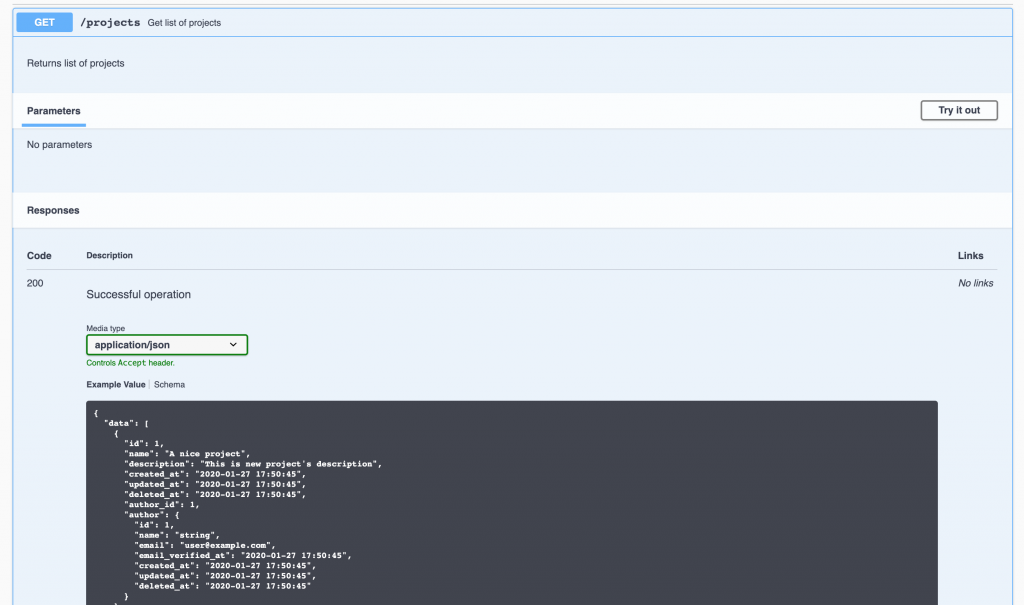
Finally, a nice small thing on this documentation page is that you can click “Try it out” (see top-right of the screenshot above) and it would try to actually run that API call. But keep in mind that you have to be authenticated exactly as your API requests.
Conclusion and “Quicker” Alternative to OpenAPI
If you are anything like me as I was reading about OpenAPI the first time, it’s a huge amount of information to take in. And it seems like a hell of a lot of work just to generate the documentation, right?
But if you’re dealing with a larger project, you would inevitably have to spend a lot of time on documentation, and that OpenAPI is a standard for almost everyone these days, so it’s useful to invest in it.
It wouldn’t be so applicable to smaller projects, may even sound an overkill. So for those, I would recommend another Laravel package, which requires less amount of comments to generate roughly similar documentation HTML: mpociot/laravel-apidoc-generator
As promised, Github repository for this article is here: LaravelDaily/Laravel-OpenAPI-Swagger-Documentation-Example
